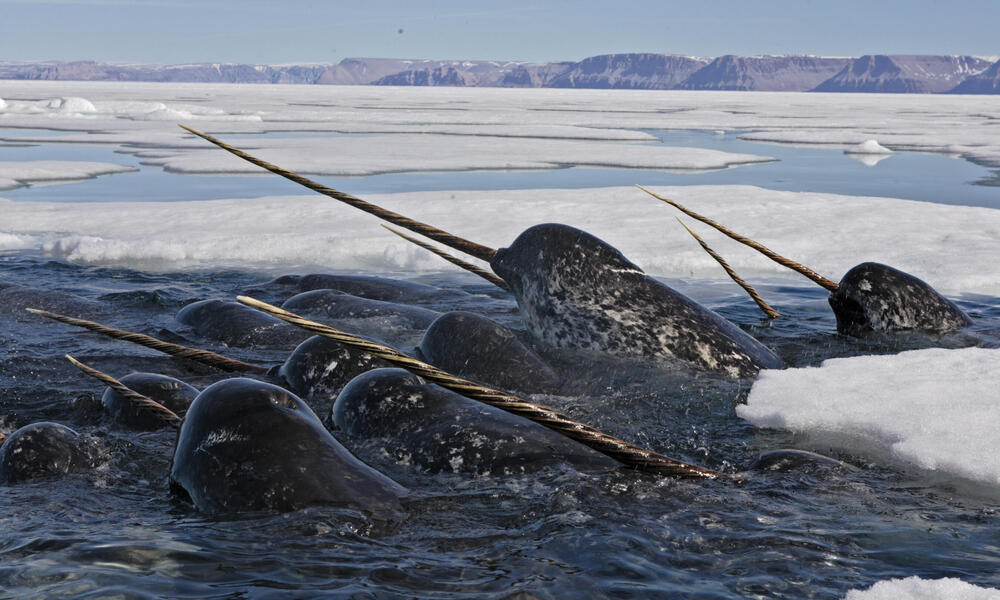Narwhals are mysterious, captivating creatures of the Arctic. Known for their long, spiraled tusk, they are often called the “unicorns of the sea.” Narwhals have intrigued scientists, explorers, and enthusiasts for centuries. But as we admire these unique marine mammals, one question often arises: Are narwhals dangerous to humans? To answer this, let’s explore their behavior, anatomy, and the circumstances in which narwhals might become a risk.
Narwhals
Narwhals had its tusk sold as a unicorn horn and was thought to be able to magically cure all illnesses in the Middle Ages
• It belongs to the cetacean suborder odontoceti, or “toothed whales “, like sperm whales and dolphins
• It got its name from the Old Norse “nar” (corpse) and “hvalr” (whale) because of its habit of lying inactive at the water’s surface and its pale colour
• It has a spiral tusk that grooves naturally to the left • is one of the deepest diving cetacean, or whale.
Introduction : Narwhals
Narwhals (Monodon monoceros) are considered medium-sized odontocetes, or toothed whales (the largest being the sperm whale, and the smallest. Then, the harbour porpoise), being of a similar size to the beluga, its close relative.
Males can grow up to 6.2 m -the average size being 4.7 mand weigh about 1,600 kg. Females tend to be smaller, with an average size of 4 m and a most size of 5.1 m and weigh around 900 kg. A newborn calf is about 1.6 m long and weighs about 80 kilograms.
The narwhal has a deep layer of fat, or blubber, about 10 cm thick. Which forms about one-third of the animal’s weight and acts as insulation in the cold Arctic waters. Source- Mondon Monoceros
Habitats and Habits
Habitat requirements of narwhals are little known. The fact that they remain year-round in Arctic waters, which are covered by sea ice for most of the year. That’s makes the study of narwhal habitat somewhat difficult.
But we do know that ice is important to the species. As it dictates migration patterns habits and habitat needs. Indeed, narwhals have adapted to live in these cold waters and rarely venture into warmer areas. Where they would meet with more predators like the killer whale or have to compete with other whale species for food.
Breeding:
Research suggests that female narwhals reach sexual maturity. It can start reproducing, at eight to twelve years of age, and males, at a much older age.
Narwhals mate in the spring, from March to May, and females give birth during the summer of the following year.
Thus, the gestation period is approximately 14 months long! Calves are born one at a time, and are nursed for about 20 months.
As they are born with a very thin layer of blubber, they need their mothers’ milk, which is rich in fat. To develop the insulation and fat storage needed for winter survival in cold waters. During the nursing period, they stay in close contact with their mothers, where they can learn the skills they will need later in their lives.
Most female narwhals can reproduce every three years. But many females give birth at longer intervals. This slow reproduction means that a population grows very slowly.
Narwhal Anatomy and Unique Adaptations
Narwhals are medium-sized whales found in Arctic waters. Males typically weigh around 3,500 pounds and can reach lengths of 16 feet. One of the most distinct features of a narwhal is its long tusk. This tusk, which can grow over 10 feet, is actually an elongated tooth. It grows through the upper lip, spiraling outwards in a fascinating, twisted pattern.
While it might look like a dangerous weapon, the narwhal’s tusk is mainly a sensory organ. Scientists believe that the tusk can detect temperature, pressure, and even chemical changes in the water. Although its sharp appearance may seem threatening, narwhals rarely use their tusks for aggression. Unlike other marine mammals, narwhals do not rely on their tusks for defense. Instead, they use them to gather information about their environment.
Narwhal Behavior and Social Dynamics
Narwhals are social animals. They travel in groups called pods, which typically consist of 10 to 20 individuals. These pods can be larger during certain seasons, especially during migrations. Narwhals are generally peaceful, spending their time feeding, resting. It’s traveling in the cold Arctic waters.
Narwhals are shy and cautious by nature. They tend to avoid encounters with unfamiliar creatures, including humans. When they sense danger, they prefer to dive to greater depths rather than confront it. Narwhals can dive as deep as 5,000 feet to evade potential threats. This impressive diving ability helps them avoid predators, including humans who venture into their territory.
Are Narwhals Aggressive Towards Humans?
In general, narwhals are not aggressive towards humans. They are naturally elusive and rarely interact with people. Most narwhal encounters with humans are peaceful and uneventful. However, like any wild animal, narwhals may react defensively if they feel threatened or cornered. If a narwhal is startled, it might act unpredictably, but it will usually flee rather than attack.
Narwhals have been observed sparring with their tusks, but this behavior is mostly seen between males during mating seasons. These sparring matches are ritualistic and do not result in serious injuries. They use their tusks to establish dominance within the pod rather than to harm others. There are no recorded cases of narwhals using their tusks aggressively against humans.
Narwhal Habitats and Human Encounters
Narwhals inhabit some of the most remote and inaccessible areas on the planet. They thrive in the cold waters of the Arctic, mainly around Greenland, Canada, and Russia. Because their habitat is so harsh and remote, human encounters with narwhals are rare. Unlike dolphins or orcas, which can be found in temperate regions, narwhals are rarely seen outside their icy Arctic range.
When humans do venture into narwhal territory, they usually do so for research, conservation, or ecotourism. Researchers and tourists who observe narwhals maintain strict distance guidelines to cut disturbance. In most cases, narwhals are curious but cautious, and they rarely approach boats or swimmers. This cautious behavior reduces the risk of dangerous encounters.
The Role of the Narwhal’s Tusk in Human-Narwhal Interactions
The narwhal’s tusk is an intriguing feature that attracts human curiosity. Many people assume the tusk is a dangerous weapon, but it serves a different purpose. Scientists believe the tusk has sensory functions, helping narwhals navigate and detect changes in their environment. Some narwhals have been observed using their tusks to tap and detect fish, possibly to locate prey.
Despite its imposing appearance, the tusk is not designed for attacking or self-defense. Narwhals do not use their tusks to hunt or harm other whale animals. Instead, they use echolocation to locate food sources. By producing clicks and whistles, narwhals can sense the size, shape, and distance of objects around them. This echolocation skill makes them effective hunters without needing to use their tusks aggressively.
Are Narwhals Dangerous in Captivity?
Narwhals do not thrive in captivity. In fact, attempts to keep narwhals in aquariums have often resulted in failure. Narwhals have unique physiological and environmental needs that are difficult to replicate in a controlled setting. They rely on deep waters and specific temperature ranges, which most facilities cannot provide.
Because narwhals are rarely kept in captivity, there are no recorded cases of narwhal aggression towards humans in such settings. Their wild nature and specialized habitat make them unsuitable for aquariums or marine parks. Even if narwhals were kept in captivity, their cautious and elusive behavior suggests that they would not pose a danger to humans.
The Dangers of Human Disturbance in Narwhal Habitats
Human activities, such as industrial development, shipping, and noise pollution, are increasingly affecting narwhal habitats. Climate change and melting ice also threaten their natural environment. As ice retreats, narwhals are forced to adapt to new migration routes, increasing the chances of human encounters.
Noise pollution is a significant concern. Narwhals rely on echolocation to communicate and navigate. Loud noises from ships, drilling, and other human activities disrupt their natural behaviors. These disturbances can cause stress and confusion among narwhals, leading them to avoid certain areas or alter their behavior. Although narwhals are not dangerous by nature. stress caused by human disturbance could make them more unpredictable in some situations.
Conservation Efforts and Reducing Risks
Conservationists and scientists are working to protect narwhal habitats and human impact. Protecting Arctic waters from industrial activities, such as oil drilling. It helps reduce the risk of dangerous encounters. Organizations and governments are also implementing regulations to limit ship traffic and noise pollution in narwhal territories.
Education plays a vital role in reducing risks as well. Tourists, researchers, and locals need to understand narwhal behavior to ensure safe interactions. Ecotourism initiatives often provide guidelines for observing narwhals from a distance. By respecting these guidelines, humans can enjoy observing narwhals without causing harm or stress to the animals.
Safety Tips for Observing Narwhals in the Wild
If you plan to observe narwhals in their natural habitat, follow these safety tips:
- Maintain a Safe Distance:Keep a distance of at least 300 feet from narwhals. This distance helps avoid disturbing the animals.
- Stay Quiet and Avoid Sudden Movements:Narwhals are sensitive to noise and sudden actions. Keeping calm reduces stress for the animals.
- Use Binoculars for Close Viewing:Avoid approaching narwhals directly. Use binoculars or zoom lenses for better views.
- Avoid Areas with Mothers and Calves:Narwhal mothers are protective of their young. Stay clear of family groups to avoid causing distress.
- Respect Local Regulations: Many Arctic regions have rules for wildlife observation. Follow these rules to protect both humans and narwhals.
- Avoid Feeding or Attracting Narwhals: Feeding wild narwhals is dangerous and can disrupt their natural behaviors.
Narwhals and the Future
Narwhals are peaceful creatures that face growing threats from human activities and climate change. Although they are not naturally dangerous to humans, our actions can impact their behavior and environment. The more we learn about narwhals, the better we can protect them and minimize the risks associated with human interactions.
Efforts to preserve Arctic habitats, reduce noise pollution, and manage human activities will help ensure that narwhals can continue to thrive in the wild. Observing these animals respectfully and responsibly is key to coexisting with them peacefully.
Conclusion: Are Narwhals Dangerous?
In summary, narwhals are not dangerous animals. They are elusive, peaceful, and generally avoid human interaction. Their tusks, though impressive, are not used for aggression. Narwhals prefer to retreat rather than confront threats, making them among the least aggressive marine mammals.
While narwhals are not dangerous by nature, respecting their habitats and minimizing disturbances is essential. By observing these guidelines, we can appreciate the beauty and mystery of narwhals without causing harm. Narwhals are a symbol of the Arctic, a reminder of nature’s wonders, and a testament to the peaceful coexistence possible between humans and wildlife.




Pingback: Top 10 Small Exotic Animals For Pets
Pingback: Are Narwhals Real? 10 Amazing Facts